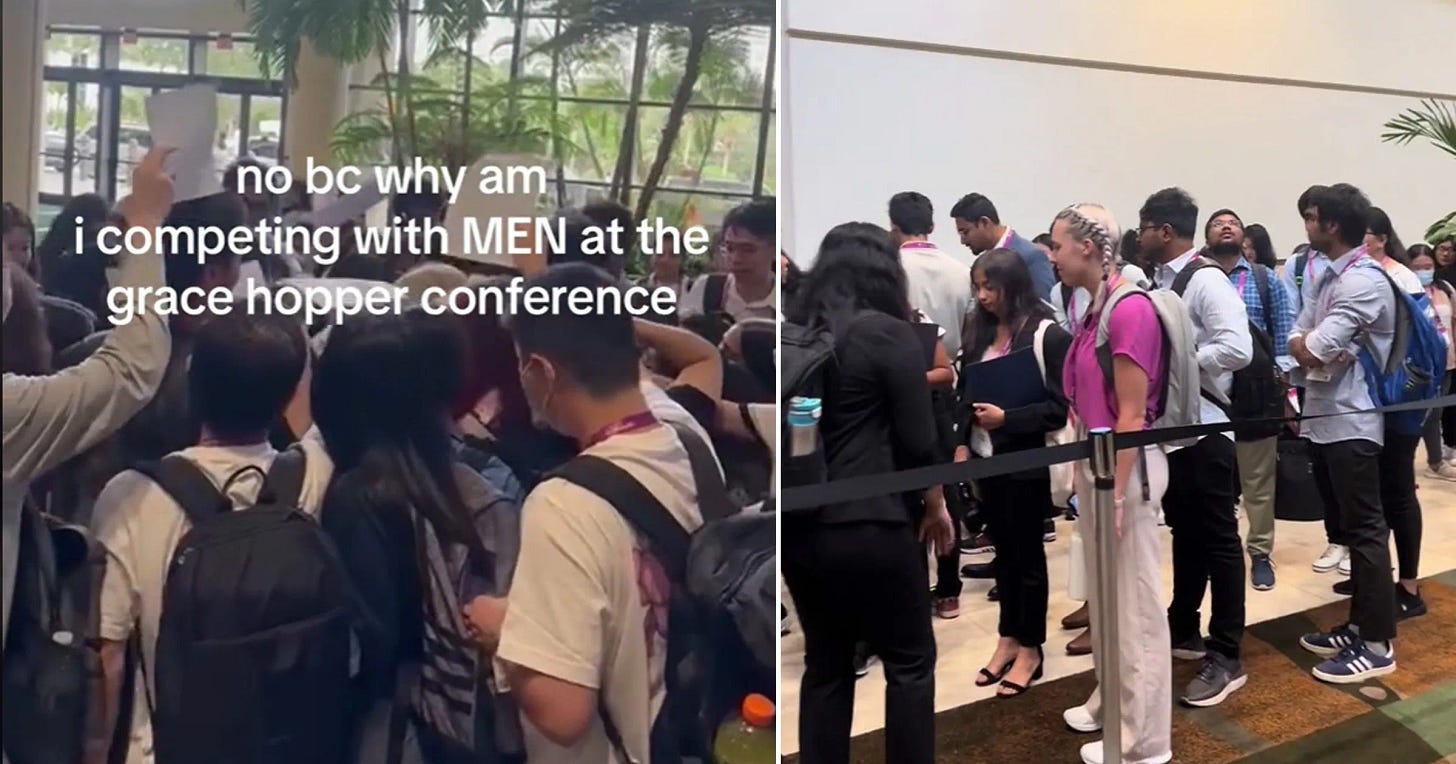Warnings Ignored: How the Grace Hopper Incident Exposed Systemic Failures
How the Grace Hopper Celebration exposed the flaws in employment visa programs and highlighted the urgent need for action

In October 2023, the Grace Hopper Celebration of Women in Computing (GHC)—the world’s largest conference for women in tech—should have been a moment of empowerment and progress. Instead, it became a stark reminder of how fragile women-centered spaces can be. After opening up admission to nonbinary people, the event saw an influx of male job-seekers—widely presumed to be international—disrupt the event and sideline the women it was meant to uplift. What should have been a celebration of women’s achievements in tech turned into yet another struggle for space in a male-dominated industry.
This isn’t just an isolated incident. It’s part of a larger pattern where women bear the brunt of systemic issues years before anyone else pays attention. The events at GHC illustrate how employment visa programs can undermine American employment opportunities—and why this must change.
From Opportunity to Exclusion: What Went Wrong at GHC
The Grace Hopper Celebration has always been a lifeline for women in tech. With women holding only 27.6% of tech jobs nationally, conferences like GHC offer rare opportunities for networking, mentorship, and career advancement. But in 2023, many women found themselves pushed aside. Male attendees dominated the career fair, cutting lines, monopolizing recruiters’ time, and crowding women out of spaces they paid to access.
For one attendee, the experience was “demoralizing.” She explained, “I waited in line for over an hour to speak with a recruiter, only to be brushed aside by a group of men who cut in front of me. This was supposed to be our space.”
Such stories reflect a larger truth: when spaces meant for women are invaded, the consequences are immediate and deeply felt. This isn’t just about the invasion of women’s spaces, but also about systemic failures that allow such disruptions to occur in the first place.
What’s the Role of the H-1B Visa Program?
The H-1B visa program allows U.S. companies to hire foreign workers for specialized jobs, particularly in fields like technology and finance. While the program was created to address skill shortages, it has evolved into a system that often prioritizes corporate cost-cutting over equity and fairness. This has significant implications for women in the workforce.
Key problems with the H-1B program include:
Lower Wages: H-1B workers are often paid less than their U.S. counterparts. This wage suppression not only hurts domestic workers but also discourages companies from investing in local talent.
Job Displacement: Major companies frequently sponsor H-1B visas while laying off thousands of domestic employees. In 2023, one tech giant laid off 6,500 U.S. workers while sponsoring 5,400 H-1B visas.
Exploitation: H-1B visa holders are often dependent on their employers, leaving them vulnerable to unfair treatment and unable to advocate for better conditions.
The tech sector is especially affected, but the ripple effects extend to finance, education, and healthcare, compounding the challenges women face in these fields.
Women Sound the Alarm—But Who’s Listening?
The disruption at Grace Hopper is a clear example of how women often identify systemic problems early, only to have their concerns dismissed until men are affected. This incident highlighted the inequities programs like the H-1B visa, emphasizing how it deepens gender imbalances in male-dominated fields like tech. Yet these warnings only gained traction when conservative, influencers on Twitter/X began raising alarms about job displacement—many of whom had their accounts promptly demonetized for challenging the globalist agenda.
Even now, the few critical discussions about the H-1B program that have happened, remained limited to Twitter/X. Conservative media largely avoids the topic, while liberal outlets tend to frame it favorably, overlooking its broader impact on domestic workers.
The delay in discussion mirrors broader societal trends. In early 2023, women made up 69.2% of tech layoffs, but this disproportionate impact was largely ignored. Only when layoffs began affecting male-dominated teams did the H-1B issue gain widespread attention. Systemic issues are too often dismissed as 'women's problems'—until they start affecting men as well.
Regional Trends in the H-1B Program
In the Southeast, states like Georgia, North Carolina, and Florida rely heavily on H-1B workers in tech, finance, and education. Major sponsors include companies like IBM, Duke University, and Citibank. While these employers benefit from the program, local job markets are affected, especially for women competing in male-dominated industries. These regional dynamics highlight the need for balance between utilizing foreign talent and investing in domestic pipelines.
Toward Solutions: What Can Be Done?
The issues raised by the GHC disruption and the H-1B program require systemic change. Here are some feminist-driven solutions to address these challenges:
Strengthen Domestic Talent Pipelines:
Companies should invest in training and mentorship programs that specifically support women in tech.Reform the H-1B Program:
Introduce measures to ensure H-1B visas don’t displace qualified domestic workers or suppress wages. For example, requiring companies to demonstrate active recruitment of local talent before hiring H-1B workers.Enforce Equity in Hiring Practices:
Employers must prioritize diversity in their hiring processes and ensure women-centered initiatives remain dedicated to uplifting women.Advocate for Women-Centered Policies:
Policymakers should consult women-led organizations when crafting immigration and labor policies to ensure our concerns are addressed.
Why Women’s Warnings Matter
The Grace Hopper incident, in late 2023, underscores a vital truth: women’s challenges are not isolated—they are red flags signaling broader systemic issues. Yet, as we enter 2025, these warnings remain largely unheeded, reflecting society’s ongoing disregard for women’s concerns and its role in stalling progress for American workers.
By listening to women and taking our concerns seriously, policymakers can address these inequities head-on, creating industries where every American has a fair shot at success. It’s time to stop treating women’s struggles as an afterthought and start recognizing them for what they are: the first signs of a system in need of change.


